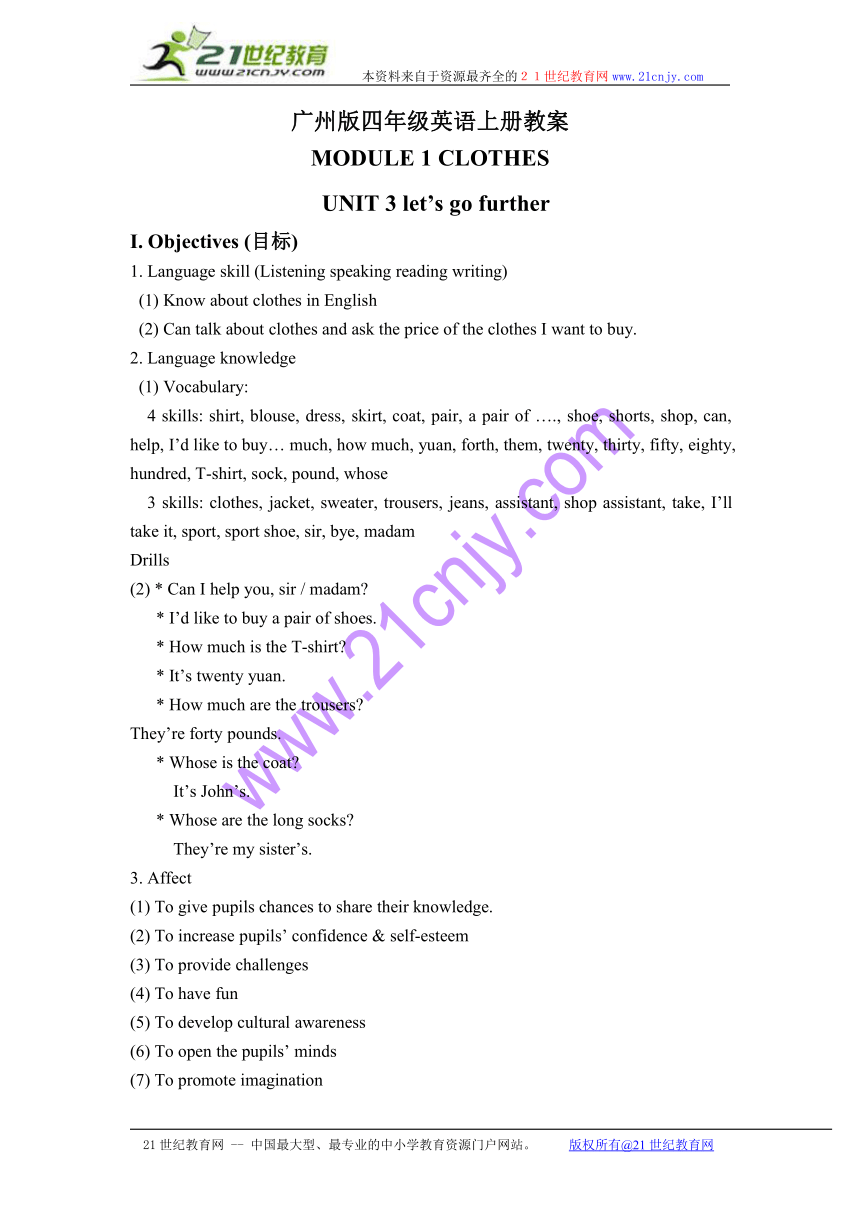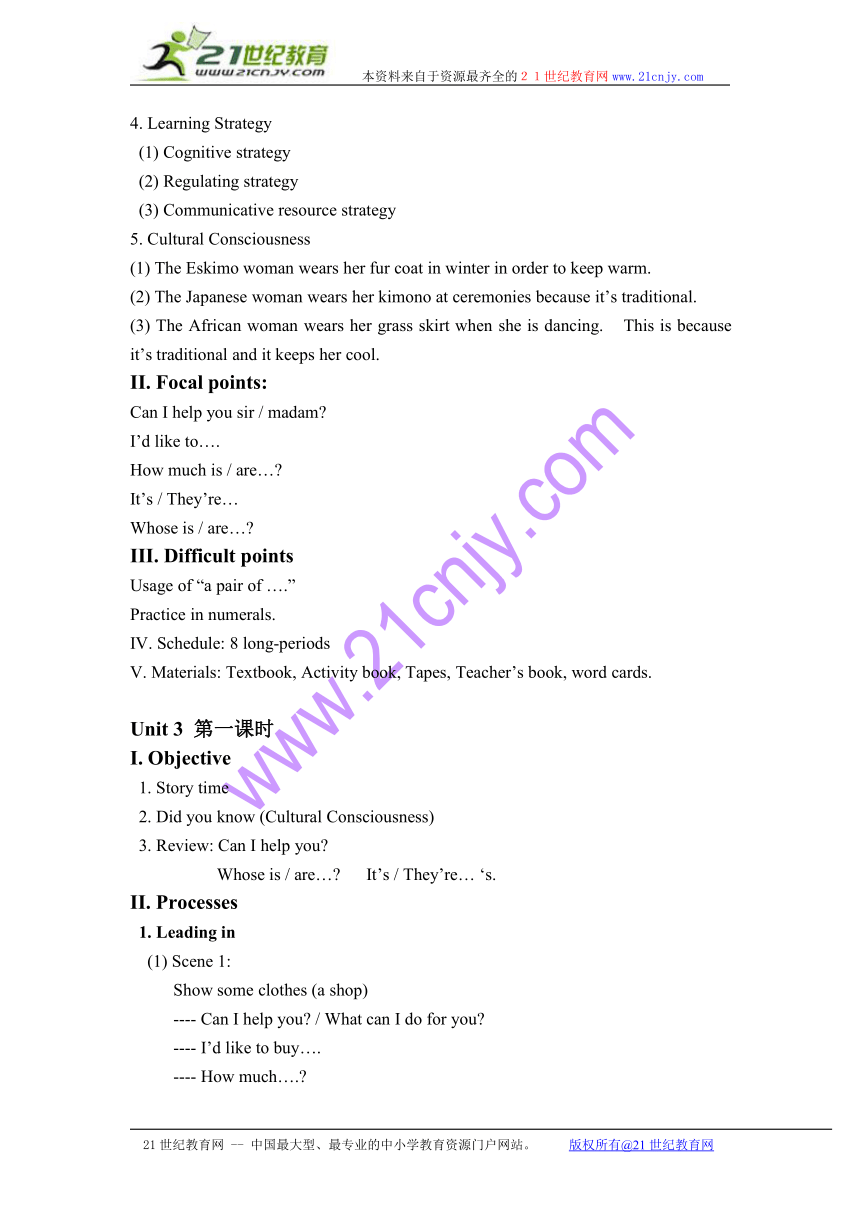四年级英语上册教案 module 1 unit 3(2)(广州版)
文档属性
| 名称 | 四年级英语上册教案 module 1 unit 3(2)(广州版) |  | |
| 格式 | rar | ||
| 文件大小 | 13.1KB | ||
| 资源类型 | 教案 | ||
| 版本资源 | 广州版 | ||
| 科目 | 英语 | ||
| 更新时间 | 2010-01-04 19:09:00 | ||
图片预览


文档简介
本资料来自于资源最齐全的21世纪教育网www.21cnjy.com
广州版四年级英语上册教案
MODULE 1 CLOTHES
UNIT 3 let’s go further
I. Objectives (目标)
1. Language skill (Listening speaking reading writing)
(1) Know about clothes in English
(2) Can talk about clothes and ask the price of the clothes I want to buy.
2. Language knowledge
(1) Vocabulary:
4 skills: shirt, blouse, dress, skirt, coat, pair, a pair of …., shoe, shorts, shop, can, help, I’d like to buy… much, how much, yuan, forth, them, twenty, thirty, fifty, eighty, hundred, T-shirt, sock, pound, whose
3 skills: clothes, jacket, sweater, trousers, jeans, assistant, shop assistant, take, I’ll take it, sport, sport shoe, sir, bye, madam
Drills
(2) * Can I help you, sir / madam
* I’d like to buy a pair of shoes.
* How much is the T-shirt
* It’s twenty yuan.
* How much are the trousers
They’re forty pounds.
* Whose is the coat
It’s John’s.
* Whose are the long socks
They’re my sister’s.
3. Affect
(1) To give pupils chances to share their knowledge.
(2) To increase pupils’ confidence & self-esteem
(3) To provide challenges
(4) To have fun
(5) To develop cultural awareness
(6) To open the pupils’ minds
(7) To promote imagination
4. Learning Strategy
(1) Cognitive strategy
(2) Regulating strategy
(3) Communicative resource strategy
5. Cultural Consciousness
(1) The Eskimo woman wears her fur coat in winter in order to keep warm.
(2) The Japanese woman wears her kimono at ceremonies because it’s traditional.
(3) The African woman wears her grass skirt when she is dancing. This is because it’s traditional and it keeps her cool.
II. Focal points:
Can I help you sir / madam
I’d like to….
How much is / are…
It’s / They’re…
Whose is / are…
III. Difficult points
Usage of “a pair of ….”
Practice in numerals.
IV. Schedule: 8 long-periods
V. Materials: Textbook, Activity book, Tapes, Teacher’s book, word cards.
Unit 3 第一课时
I. Objective
1. Story time
2. Did you know (Cultural Consciousness)
3. Review: Can I help you
Whose is / are… It’s / They’re… ‘s.
II. Processes
1. Leading in
(1) Scene 1:
Show some clothes (a shop)
---- Can I help you / What can I do for you
---- I’d like to buy….
---- How much….
---- It’s / They’re…
---- OK. I’ll take…
---- Here you are.
---- Thank you.
(2) Scene 2 (At a friend’s home)
-- Hello
-- Hello
-- Whose is / are…
-- It’s / They’re….’s
(3) dictation forty – sport, shoe
2. Presentation
(1) show some pictures; explain the pictures one bye one.
(2) repeat the sentences:
it’s got…
why are you…
What do you mean
(3) P12 listen to the tape
(4) read after the tape twice
(5) read in groups
(6) act out the story
(7) P13 Did you know
The Eskimo woman wears her fur coat in winter in order to keep warm.
The Japanese woman wears her kimono at ceremonies because it is traditional.
The African woman wears her grass skirt, when she is dancing. This is because it is traditional and it keeps her cool.
3. Practice and development
(1) 活 P8 Ex. 5 (先对个别题指导 → 自做 → 校对)
(2) 活P7 Ex. 3 Ex.4
Homework:
1. 活 P5 Ex.1 P60 – P62 U2单词
2. 改正听写
3. 听录音读Module 1 3次
Unit 3 第一课时
I. Objectives
1. Review: Clothes in English
2. Can talk about clothes and ask the price of the clothes I want to buy.
3. Do some exercises.
II. Processes
1. dictation: (read the words first)
sir madam bye pound whose
2. act out Unit 1 in groups
3. (1) whole class read Unit 2
(2) ask students to act out U2
4. game
(1) 从苹果权吉找出与a pair of 配对的苹果
skirt, dress, shoes, jeans, trousers, blouse, socks, boots
(2) 把苹果正确分类后,请生按自己的喜好买苹果用上:
---- Can I help you / What can I do for you
---- I’d like to buy…
---- How much….
---- It’s / They’re…
---- I’ll take
(3) 各生把苹果买回校后,打乱顺序,请他人猜
---- Whose is / are….
---- It’s / They’re…’s.
《技》P1. Ex.一 Ex.二
P3. Ex.一. 二
Homework:
技 P2. Ex. 五. 六
P4. Ex. 五. 六
听录音,预习Unit 4 (词)
自学 P14 Additional words
21世纪教育网 -- 中国最大型、最专业的中小学教育资源门户网站。 版权所有@21世纪教育网
广州版四年级英语上册教案
MODULE 1 CLOTHES
UNIT 3 let’s go further
I. Objectives (目标)
1. Language skill (Listening speaking reading writing)
(1) Know about clothes in English
(2) Can talk about clothes and ask the price of the clothes I want to buy.
2. Language knowledge
(1) Vocabulary:
4 skills: shirt, blouse, dress, skirt, coat, pair, a pair of …., shoe, shorts, shop, can, help, I’d like to buy… much, how much, yuan, forth, them, twenty, thirty, fifty, eighty, hundred, T-shirt, sock, pound, whose
3 skills: clothes, jacket, sweater, trousers, jeans, assistant, shop assistant, take, I’ll take it, sport, sport shoe, sir, bye, madam
Drills
(2) * Can I help you, sir / madam
* I’d like to buy a pair of shoes.
* How much is the T-shirt
* It’s twenty yuan.
* How much are the trousers
They’re forty pounds.
* Whose is the coat
It’s John’s.
* Whose are the long socks
They’re my sister’s.
3. Affect
(1) To give pupils chances to share their knowledge.
(2) To increase pupils’ confidence & self-esteem
(3) To provide challenges
(4) To have fun
(5) To develop cultural awareness
(6) To open the pupils’ minds
(7) To promote imagination
4. Learning Strategy
(1) Cognitive strategy
(2) Regulating strategy
(3) Communicative resource strategy
5. Cultural Consciousness
(1) The Eskimo woman wears her fur coat in winter in order to keep warm.
(2) The Japanese woman wears her kimono at ceremonies because it’s traditional.
(3) The African woman wears her grass skirt when she is dancing. This is because it’s traditional and it keeps her cool.
II. Focal points:
Can I help you sir / madam
I’d like to….
How much is / are…
It’s / They’re…
Whose is / are…
III. Difficult points
Usage of “a pair of ….”
Practice in numerals.
IV. Schedule: 8 long-periods
V. Materials: Textbook, Activity book, Tapes, Teacher’s book, word cards.
Unit 3 第一课时
I. Objective
1. Story time
2. Did you know (Cultural Consciousness)
3. Review: Can I help you
Whose is / are… It’s / They’re… ‘s.
II. Processes
1. Leading in
(1) Scene 1:
Show some clothes (a shop)
---- Can I help you / What can I do for you
---- I’d like to buy….
---- How much….
---- It’s / They’re…
---- OK. I’ll take…
---- Here you are.
---- Thank you.
(2) Scene 2 (At a friend’s home)
-- Hello
-- Hello
-- Whose is / are…
-- It’s / They’re….’s
(3) dictation forty – sport, shoe
2. Presentation
(1) show some pictures; explain the pictures one bye one.
(2) repeat the sentences:
it’s got…
why are you…
What do you mean
(3) P12 listen to the tape
(4) read after the tape twice
(5) read in groups
(6) act out the story
(7) P13 Did you know
The Eskimo woman wears her fur coat in winter in order to keep warm.
The Japanese woman wears her kimono at ceremonies because it is traditional.
The African woman wears her grass skirt, when she is dancing. This is because it is traditional and it keeps her cool.
3. Practice and development
(1) 活 P8 Ex. 5 (先对个别题指导 → 自做 → 校对)
(2) 活P7 Ex. 3 Ex.4
Homework:
1. 活 P5 Ex.1 P60 – P62 U2单词
2. 改正听写
3. 听录音读Module 1 3次
Unit 3 第一课时
I. Objectives
1. Review: Clothes in English
2. Can talk about clothes and ask the price of the clothes I want to buy.
3. Do some exercises.
II. Processes
1. dictation: (read the words first)
sir madam bye pound whose
2. act out Unit 1 in groups
3. (1) whole class read Unit 2
(2) ask students to act out U2
4. game
(1) 从苹果权吉找出与a pair of 配对的苹果
skirt, dress, shoes, jeans, trousers, blouse, socks, boots
(2) 把苹果正确分类后,请生按自己的喜好买苹果用上:
---- Can I help you / What can I do for you
---- I’d like to buy…
---- How much….
---- It’s / They’re…
---- I’ll take
(3) 各生把苹果买回校后,打乱顺序,请他人猜
---- Whose is / are….
---- It’s / They’re…’s.
《技》P1. Ex.一 Ex.二
P3. Ex.一. 二
Homework:
技 P2. Ex. 五. 六
P4. Ex. 五. 六
听录音,预习Unit 4 (词)
自学 P14 Additional words
21世纪教育网 -- 中国最大型、最专业的中小学教育资源门户网站。 版权所有@21世纪教育网
同课章节目录
- Module 1 My bedroom
- Unit 1 What's in your room?
- Unit 2 They're near the window
- Module 2 My house
- Unit 3 Welcome to my house
- Unit 4 I live in a big house
- Module 3 My school
- Unit 5 Let me show you our new school
- Unit 6 How many classrooms are there in your schoo
- Module 4 My class
- Unit 7 How many stars does each group have?
- Unit 8 I like English best
- Module 5 Clothes
- Unit 9 Look at this T-shirt
- Unit 10 Can I help you?
- Module 6 Occupations
- Unit 11 I want to be a painter
- Unit 12 What's your father's job?
- Module 7 Let's look back
